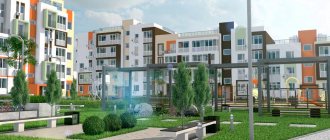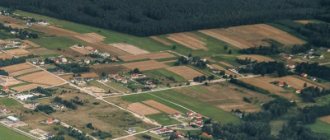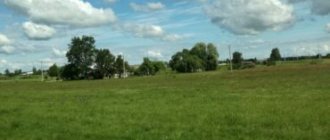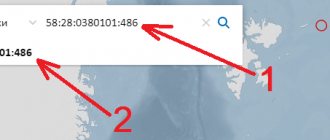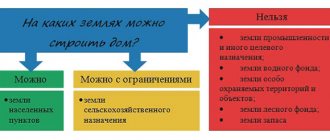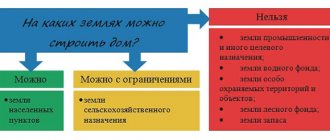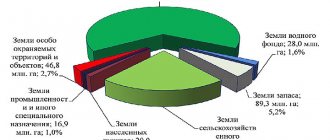All lands are divided into plots, which, in addition to the category, also have a certain type of permitted use (PUR).
This term, used in the legislative acts of the Russian Federation (Land and Town Planning Code), exists in order to determine what activities can be carried out on the site .
For example, you cannot choose any place in the city or outside the city and build a store, a shopping center there, or start growing tomatoes and potatoes.
It is necessary to know whether such activities and any construction are planned in this place at the level of urban (territorial) planning. For more information on how you can find out the VRI, read the article “How to find out the type of permitted use of a land plot.”
The types of permitted use of a land plot (VRI ZU), according to the current classifier, are indicated in the urban zoning document “Land Use and Development Rules” (LZZ) of the city (which also indicates the size of the plot and the buildings located on it, restrictions on use and calculated indicators).
Each land plot has three types of permitted use, according to the Town Planning Code of the Russian Federation, Art. 37:
- basic,
- conditional,
- auxiliary
Why is a classifier needed?
In order to structure and classify information about VRI, in 2014 Order 540 “On approval of the classifier of types of permitted use of land plots” was adopted.
In 2015, changes were made that are in effect today.
Prior to this, there were no clear rules for the formulation of types of permitted uses, and they had no classification.
Some names were quite vague and did not have a clear meaning.
The owner of the site chooses the activity in accordance with the main or auxiliary VRI himself, without additional permits . For a conditional VRI, the owner must obtain permission.
To summarize: a classifier of permitted use of land plots is a document containing a list of all types of permitted use. Many of them acquired a more specific formulation of meaning, which does not imply other options for its interpretation.
What it is?
The Land Code divides lands by category and permitted use . The category of land is a broader concept.
There are 7 categories in total, these are lands:
- Settlements;
- Farmland;
- Forest fund or economy;
- Special purposes;
- Natural areas;
- Water Fund;
- National reserve.
Permitted use is a narrower concept, necessary to clarify the intended use of a specific plot.
All types for each category are indicated in a special classifier.
Read more about the classifier in the feature article.
Main differences of the new classifier
The first section (code 1.0) describes all possible types of agricultural use with a description of buildings and structures.
All types of gardening and dacha management are included in the new code 13 (13.1., 13.2., 13.3).
Peasant farming is not mentioned at all, and all types of residential construction have acquired a more streamlined classification.
Design
Design of low-rise residential buildings:
- individual,
- apartment buildings up to 3 floors;
- blocked.
Their construction is permitted without state safety assessment of the project, carrying out and analyzing the results of geotechnical work.
When designing, it is necessary to comply with the requirements of building rules and regulations for the construction of single-apartment and low-rise multi-apartment residential buildings SP 55.13330.2011, the general requirements of the set of rules for the design of low-rise development of settlements SP 30-102-99, the installation of water supply, heat supply and sewerage networks, PUE, fire safety rules safety, other regulatory and technical documentation according to local conditions.
Which VRI are suitable for individual construction
According to the classifier, the following areas are suitable .
Residential buildings for permanent residence
In areas with a permitted use code:
- 2.0. – residential development;
- 13.2. – gardening;
- 13.3 – maintaining a dacha farm (in accordance with Federal Law N217, which comes into force in 2021).
Seasonal residential properties
In areas with code:
- 13.1. – conducting vegetable gardening ( only non-capital construction );
- 13.2. – gardening;
- 13.3. - maintaining a dacha farm.
Non-residential buildings, structures and structures
In areas with code 1.0. – agricultural use (auxiliary structures for farming), in areas with code 4.0 – entrepreneurship (construction of non-residential buildings for the purpose of making a profit).
How to remove a land plot from industrial land?
The removal of a site from industrial land is carried out through a change in its category. The main advantage of industrial sites is that they can be transferred to any category. But there are also difficulties in removing plots from this category.
- The presence of real estate on the territory that needs to be demolished, or various contaminations, complicate the procedure. Before changing the purpose of the site, a reclamation project will have to be developed and approved.
- During the use of such lands, the top layers of soil were disturbed; before being transferred to a new category, they will have to be restored. Restoration is carried out in accordance with the reclamation project, which must be approved by the authorized body.
To remove a site from industrial land, it is necessary to decide on the agency that will decide this issue. If the plot is owned by a private individual or owned by a municipality, the application is submitted to local government bodies (land committee). If the territory belongs to the state, the application for withdrawal is sent to the executive authority. When you have decided on the addressee of the application, you can proceed to the procedure for changing the category.
- An appeal is drawn up in the form prescribed by law. It indicates the cadastral number of the plot, its current and desired category, the rationale for the need to change the purpose and the right that the applicant has to the plot.
- A package of documentation is being collected, including an extract from the Unified State Register, from the state cadastre, and a state conclusion. examination, owner’s consent to deregister industrial land. A remediation project that has been approved may also be required.
- After paying the state fee (the receipt is included in the package of papers), you must submit an application to the authorized body and wait for a decision. The executive authority will consider the application for up to 3 months. Local authorities make a decision within 2 months.
- Having received the act of transferring the site to another category, new data is registered in Rosreestr. The municipality sends such a request on its own, but sometimes the applicant has to take the initiative.
The procedure for removing a site from industrial land is long. It requires special knowledge and experience. Entrust the land lawyers of our company to carry it out, and the change in category will take place faster and without any special difficulties.
VRI specified in the documents earlier
In the old classifier of types of permitted use of land plots (2014 document), the same codes are suitable for the construction of auxiliary and residential premises.
Only newly entered codes are missing:
- 13.1.,
- 13.2.,
- 13.3.
The classifier of types of permitted land use provided for in the town planning code
So, for example, the enlarged VRI - agricultural use - can be singled out as the main one. This means that on the site it will be possible to engage in any activity described under code 1.1 -1.18.
IMPORTANT: if some existing buildings stand on land that is not intended for them according to the new classifier, they are still recognized as legal. The owner does not need to transfer his site to another category. (according to Article 34, clause 11. Federal Law of June 23, 2014 N 171-FZ).
Types of uses that can be classified as auxiliary are also contained in the classifier under the description of the content of the extended code.
For example, code 2.5 “mid-rise residential development” includes landscaping, garages, playgrounds and sports grounds.
Most Popular
The popularity of the type of use directly depends on the category of land and the territorial zone .
Thus, in settlement lands and the “Residential Development” territorial zone, the most popular types will be:
- individual housing construction,
- LPH.
On lands intended for farmland, private household plots and peasant farms will be popular.
individual housing construction
Individual housing construction is a land plot intended for the construction of a single-apartment house with a limited number of floors .
If the size of the plot allows, you can also build a garage, utility rooms and other necessary buildings here.
You can also grow flowers, vegetables and garden crops on the site, and do landscaping.
Individual housing construction can only belong to the category of settlement land.
For detailed information about individual housing construction, read the article “What is a site for individual housing construction.”
Private household plots
Private household plot is a land plot intended for conducting agricultural activities for one’s own needs .
In this area you can:
- grow flowers,
- garden and vegetable crops,
- raise livestock
- keep poultry, etc.
It is necessary to separate household private plots (located within the ZNP) and field private plots (located within the ZSN).
On a personal plot you can build houses, garages and other structures.
On the field site, any construction that requires the construction of a foundation is prohibited, but non-permanent buildings (buildings without a foundation) are allowed.
For detailed information about construction on plots for private household plots, read the feature article.
For country house construction
Land for summer cottage construction is intended for the construction of a residential building and other economic and domestic buildings on the site , as well as for the use of the site for agricultural needs: growing garden and vegetable crops, raising livestock and poultry, etc.
Land for dacha construction can be of two types: with the right of registration in a constructed residential building and without the right of such registration.
This VRI can be assigned to an allotment in the category of ZNP lands, as well as in the category of agricultural lands, but in the second case, the owner of the plot must go through a number of certain procedures to add a conditionally permitted type (by default, capital facilities cannot be built on ZSN lands).
Read more about land for summer cottage construction in another article.
Horticulture
Allotments for gardening are allocated from agricultural lands. In such areas you can grow any vegetable crops , but you cannot build permanent structures. Greenhouses, temporary buildings and other non-permanent structures can be erected.
For detailed information, read the article Land for gardening.
Future changes
Since 2014, along with the old ones, new types of permitted use have appeared in the documents. Also, certain issues will require resolution.
For example, in some cities, industrial zones on zoning maps are designated separately, depending on the danger of detail (harmful emissions, possibility of explosion), and in the classifier everything is combined into a single production activity .
These and many other contradictions will entail changes, because, in accordance with the already mentioned Federal Law of June 23, 2014 N 171-FZ (Article 34, paragraph 12),
urban zoning documents must be amended before January 1, 2019 according to the classifier.
Since 2021, the Federal Law “On the conduct of gardening and vegetable gardening by citizens for their own needs and on amendments to certain legislative acts of the Russian Federation” will come into force, which resolves some controversial issues and clarifies missing points.
The process of change, one might say, has just begun and practice will show the future.
The existing VRI of any site (at the moment, without taking into account many changes in accordance with the classifier) can be viewed on the cadastral map of Rosreestr.
Advantages and disadvantages of low-rise buildings
Low-rise buildings are developing at a rapid pace today, and their share in the total share of housing construction is constantly increasing. This is due to the following advantages of low-rise construction:
- minimum project approvals;
- high speed of construction;
- low cost of housing;
- environmental friendliness;
- low population density per square km;
- lower costs for organizing parking lots, recreation areas, playgrounds;
- low load on adjacent roads;
- comfort of stay.
The advantages of low-rise buildings also include autonomous infrastructure, aesthetics, ease of use and the possibility of constructing housing according to individual projects.
Low-rise construction also has disadvantages:
- High cost of land for construction.
- Difficulty in registering a plot of land.
- High cost of connecting communications.
The main feature of low-rise housing is increased living comfort, high speed and ease of cocking, environmental friendliness and affordable cost. The main disadvantage of a “low-rise” building is the high price of a land plot.
What else affects the assignment of a permitted use to a site:
The type of permitted use is part of the urban planning regulations , which, in turn, is included in the Land Use and Development Rules (along with the urban zoning map).
All these documents influenced the creation of a classification of types of permitted use of land.
Thus, with the adoption of this document, the type of use is immediately assigned to the entire zone (which are highlighted on the zoning map) and includes both main, auxiliary, and conditionally permitted types at once.
This is a plus, since the site has a greater number of uses that can be easily changed .
How to convert a plot of land into industrial land?
Changing the category of a site will require serious reasons. The procedure takes a long time, you have to visit many authorities and collect documentation. The package of papers includes:
- confirmation of ownership or other possession of the site;
- layout diagram indicating the address;
- copies of cadastral certificates and real estate documents;
- territorial planning scheme;
- landlord's permission to change category.
The application and all documentation are sent to the head of the local administration. At this stage, they decide whether it is possible to convert the site into industrial land, how feasible and financially feasible this is. If the answer is positive, the second stage begins - undergoing examinations. At this stage you will need a new set of documents:
- boundary plan of the allotment;
- cadastral passport;
- confirmation of rights to the site;
- permission from the administration;
- industrial facility project;
- justification of the project;
- approvals from other authorities.
Depending on the current category of land, a different set of approvals may be required. They may request protection of a project that describes an industrial facility. If a legal entity or entrepreneur applies to change the category, you will have to provide the relevant extracts from the registers for the applicant.
In the first appeal submitted to the administration, it is important to work out in detail the reasons for changing the category. To do this, you will have to familiarize yourself with urban planning norms, land use and development rules and other regulations. When the application has been approved, and the documents have passed the necessary authorities and received approvals, it is necessary to submit a new application.
At the final stage, the application is sent to Rosreestr. The results of approvals, permission from the administration and documents for the site are attached to it. As a result, changes are made to the register, and a new category is assigned to the plot, or a refusal is issued. If you entrust the procedure for changing the category to the lawyers of our company, the risk of refusal is eliminated.

